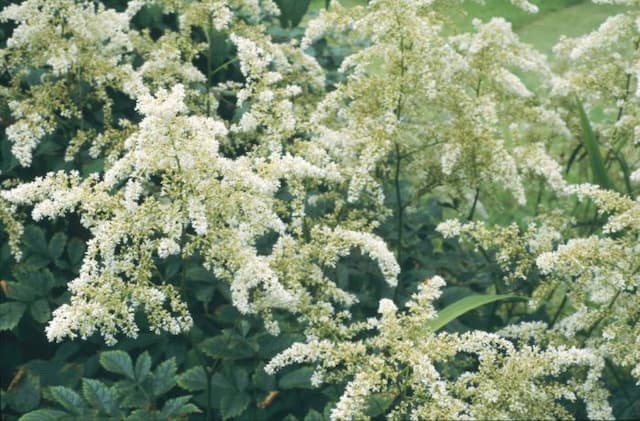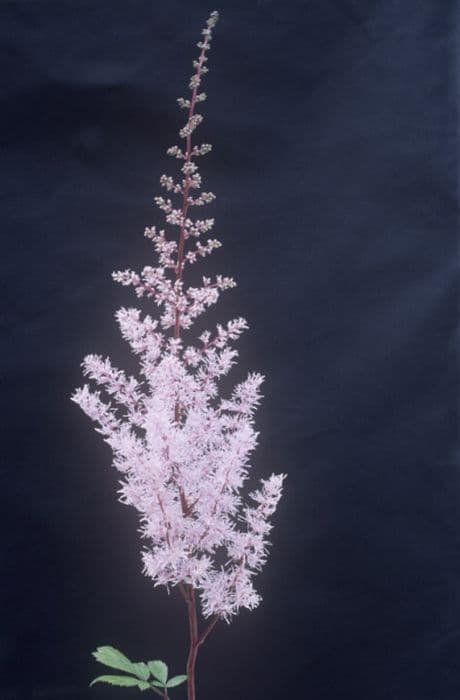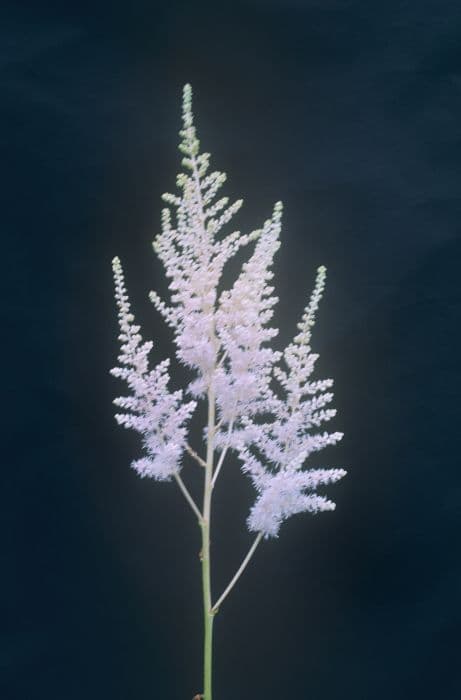Foamflower Tiarella cordifolia

ABOUT
Tiarella cordifolia, commonly known as foamflower, is an attractive perennial plant that is native to North America. Displaying a charming and delicate aesthetic, foamflower boasts heart-shaped, lobed leaves that create a lush, mound-like foliage. These leaves are often deep green in color, and some varieties may feature attractive veining or mottling that can add additional interest. In the spring to early summer, foamflower sends up slender, airy flower spikes that tower above the foliage. The tiny, star-shaped flowers are usually white or light pink and are clustered tightly together along the stems, giving the appearance of a foamy, ethereal plume. Once the blooming period is over, the flowers may be replaced by small, dry fruit capsules, but it is mainly grown for its ornamental value. Foamflower forms a spreading clump, making it a good ground cover option in shady garden spots. It can often be found enjoying the dappled light under deciduous trees or nestled among other woodland plants. Due to its intricate leaf texture and charming blossoms, it's a popular choice for temperate shade gardens and is beloved for adding a delicate and enchanting touch to the landscape.
About this plant
 Names
NamesFamily
Saxifragaceae
Synonyms
Foamflower, Heartleaf Foamflower, False Miterwort, Coolwort, Allegheny Foamflower, Mountain Foamflower
Common names
Tiarella cordifolia var. collina, Tiarella cordifolia f. alba, Tiarella cordifolia f. cordifolia, Tiarella cordifolia var. australis, Tiarella cordifolia var. cordifolia.
 Toxicity
ToxicityTo humans
Foamflower, the common name for Tiarella cordifolia, is generally considered non-toxic to humans. There are no well-documented cases of poisoning from ingesting this plant, and it does not contain any known toxic compounds that would pose a threat to human health. Consequently, ingestion of Foamflower is not expected to result in noticeable symptoms or have severe consequences for humans, although individual allergic reactions or sensitivities are always possible with any plant.
To pets
Foamflower, also known as Tiarella cordifolia, is not known to be toxic to pets. There is no evidence to suggest that ingestion of any part of the Foamflower plant poses a risk to the health of pets such as cats and dogs. Therefore, pets that consume Foamflower are unlikely to experience symptoms of poisoning, and the consumption is not expected to have harmful consequences. However, as with any plant, individual animals may have varying sensitivities or allergic reactions, so it is always wise to monitor pets and consult with a veterinarian if any adverse reactions are observed.
 Characteristics
CharacteristicsLife cycle
Perennials
Foliage type
Semi-deciduous
Color of leaves
Green
Flower color
White
Height
1 feet (0.3 meters)
Spread
1 feet (0.3 meters)
Plant type
Herb
Hardiness zones
3-9
Native area
North America
Benefits
 General Benefits
General Benefits- Groundcover: Tiarella cordifolia, commonly known as Foamflower, is effective at covering the ground, reducing soil erosion and suppressing weed growth.
- Ornamental Value: The Foamflower has attractive foliage and flowers that enhance the aesthetic appeal of gardens and naturalized areas.
- Wildlife Attraction: Foamflower blooms are known to attract pollinating insects such as bees, benefiting the pollination of nearby plants.
- Shade Tolerance: Foamflower is well-suited for shaded gardens where other plants might struggle to thrive.
- Low Maintenance: Foamflower is a low-maintenance plant that generally requires minimal care once established in a suitable location.
- Seasonal Interest: Foamflower offers seasonal interest with its spring blooms and sometimes fall color changes in the foliage.
 Medical Properties
Medical Properties- Antispasmodic: Tiarella cordifolia may have been used traditionally to help relax muscle spasms.
- Astringent: The plant has been reportedly used for its astringent properties, which could help to reduce inflammation and tighten tissues. <
 Air-purifying Qualities
Air-purifying QualitiesThis plant is not specifically known for air purifying qualities.
 Other Uses
Other Uses- Tiarella cordifolia, commonly known as Foamflower, can be used as a natural ground cover in woodland gardens to suppress weeds and maintain soil moisture without competing aggressively with neighboring plants.
- The plant is suitable for edging paths or borders, providing a decorative foliage contrast and soft texture alongside harder surfaces and amongst other perennials.
- Foamflower leaves can be used in pressed flower crafts, as they retain their shape and muted color tones when dried properly.
- The attractive foliage of Tiarella cordifolia can be photographed and used in botanical art or as a pattern in fabric designs and wallpaper, thanks to its distinctive, heart-shaped leaves and intricate venation.
- The flowers of Foamflower can be included in non-traditional floral arrangements for a natural and woodland-inspired aesthetic.
- Due to its resilient nature, Foamflower can be utilized in educational settings, such as schools or conservation areas, to demonstrate native plant gardening and the importance of biodiversity.
- When planted in outdoor gathering spaces like patios or terraces, Foamflower can contribute to a serene environment due to its calming green foliage and subtle blooms.
- In creative culinary presentations, Foamflower's foliage and flowers can be used as natural, non-toxic garnishes for plating, though they are not edible.
- Children can engage with Foamflower in nature crafts, using its leaves and blooms to create botanical sunprints on fabric or paper.
- Tiarella cordifolia can serve as a living mulch in permaculture systems, helping to retain soil moisture, regulate temperature, and build soil health through leaf litter.
Interesting Facts
 Feng Shui
Feng ShuiTiarella or foamflower is not used in Feng Shui practice.
 Zodiac Sign Compitability
Zodiac Sign CompitabilityTiarella or foamflower is not used in astrology practice.
 Plant Symbolism
Plant Symbolism- Foamflower: As its most common name, Foamflower symbolizes natural carpeting, referring to how it often spreads in the wild, creating a beautiful white and foamy-looking layer on the forest floor.
- Purity: The delicate white flowers can symbolize purity and innocence, akin to many other white flowering plants.
- Endurance: It's a hardy plant that can thrive in shade and cooler climates, thus symbolizing endurance and resilience.
- New Beginnings: Blooming in the spring, the Foamflower represents new beginnings and the awakening of nature after winter.
- Feminine allure: In some contexts, the gentle and soft appearance of the Foamflower's blooms could symbolize feminine beauty and allure.
 Water
WaterFoamflower prefers consistently moist soil, so it should be watered when the top inch of soil begins to dry out. For indoor plants, this might translate to watering approximately once a week, though this can vary based on environmental conditions. Generally, a good soaking that allows water to reach the roots without leaving the plant waterlogged is ideal. Outdoor foamflower plants might require less frequent watering due to rain, but during dry spells, watering every few days may be necessary. Depending on the size and type of the container or garden area, this could mean using around 1 gallon of water per plant each time you water.
 Light
LightFoamflower thrives best in partial to full shade, making it a great choice for shaded garden areas or north-facing windows. It should be kept out of direct sunlight, which can scorch its leaves, so a spot under a canopy of trees or beside taller plants that provide dappled shade would be an ideal location. The best lighting condition would mimic the natural light of a forest understory—bright but indirect and filtered.
 Temperature
TemperatureFoamflower is hardy in a range of temperatures and can survive in zones 3 through 9, which corresponds to a minimum temperature between -40 to -30 degrees Fahrenheit to a maximum temperature of 30 to 40 degrees Fahrenheit. The ideal temperature for active growth and health of the foamflower is between 50 and 70 degrees Fahrenheit. It can tolerate some deviation from this range, but extreme heat or frost is detrimental to the plant's health.
 Pruning
PruningPruning foamflower isn't usually necessary, but it can be beneficial for the health and appearance of the plant. Deadheading spent flowers can encourage reblooming and trimming back tattered leaves in late winter or early spring can promote fresh growth. The best time for any major pruning is in the spring, just as new growth begins, which is often once a year.
 Cleaning
CleaningAs needed
 Soil
SoilFoamflower prefers a well-draining, humus-rich soil with a pH of about 5.5 to 7. A mix containing peat moss, compost, and a bit of perlite or coarse sand is ideal for maintaining the right balance of moisture and aeration.
 Repotting
RepottingFoamflowers typically do not require frequent repotting and can be repotted every 2 to 3 years, or when they outgrow their container and become root-bound.
 Humidity & Misting
Humidity & MistingFoamflower thrives in moderate to high humidity levels. While it adapts to average household humidity, the plant benefits from increased humidity, especially during the dry winter months.
 Suitable locations
Suitable locationsIndoor
Place Foamflower in bright, indirect light with humus-rich soil mix.
Outdoor
Choose partial to full shade and moist, rich soil for outdoor Foamflower.
Hardiness zone
3-8 USDA
 Life cycle
Life cycleTiarella cordifolia, commonly known as foamflower, begins its life as a seed, which, upon finding suitably moist and shaded soil conditions, will germinate and develop into a small seedling. As it grows, the seedling develops heart-shaped leaves and a rosette form, which is characteristic of the plant in its vegetative stage. Through vegetative propagation, the foamflower also spreads by stolons (runners) that extend out and root at nodes, forming clonal colonies. Once mature enough, generally in spring to early summer, the foamflower produces tall, feathery spikes of small, starry white or pink flowers that attract pollinators, leading to cross-pollination. After pollination, the flowers develop into small dry capsules containing numerous tiny seeds, completing the reproductive stage. As a perennial, the foamflower then either dies back in the winter to re-emerge from its rootstock with the return of favorable conditions, or retains its foliage year-round in milder climates.
 Propogation
PropogationPropogation time
Spring to Summer
The most popular method of propagation for Tiarella cordifolia, commonly known as foamflower, is by division. The best time to do this is in early spring or fall when the plant is not in active bloom. To propagare the foamflower using division, carefully dig up an established clump and gently tease apart the individual crowns with your hands or a garden fork. Ensure each section has a healthy portion of roots attached. Replant the divisions immediately into prepared soil, spacing them about a foot (approximately 30 cm) apart to allow room for growth. Water them well to settle the soil around the roots and to help reduce transplant shock. This simple method helps maintain the vigor of the plant and can successfully increase the number of foamflowers in your garden.









